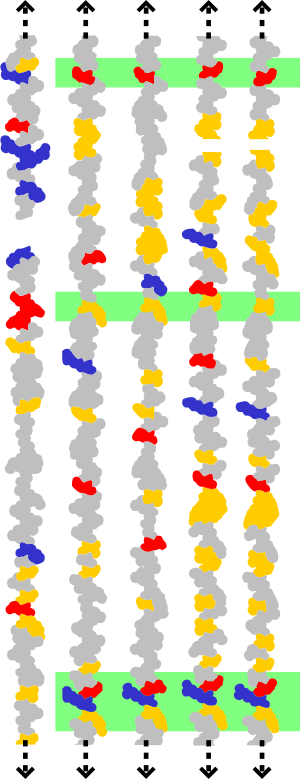Conserved sequence facts for kids
Conserved sequences are similar or identical sequences which occur in DNA, and cause sequences in RNA, proteins and carbohydrates.
These sequences occur across species. This shows that the sequences has been maintained in evolution despite speciation. The further back up the phylogenetic tree a particular conserved sequence occurs, the more highly conserved it is. Since sequence information is normally transmitted from parents to progeny by genes, a conserved sequence implies that there is a conserved gene.
Conservation of a sequence happens when mutations in a highly conserved region lead to non-viable life forms, that is, a form which is eliminated through natural selection. In other words, the product of the gene is vital to life, and its function is destroyed by almost all changes (mutations) to the sequence.
Contents
Conserved nucleic acid sequences
The basic theory, widely agreed, is that highly conserved DNA sequences must have functional value, though the role for many of these highly conserved non-coding DNA sequences is not known. One recent study that eliminated four highly conserved non-coding DNA sequences in mice yielded viable mice with no significant phenotypic differences; the authors described their findings as "unexpected". So there is clearly something here which is not understood.
Many regions of the DNA, including highly conserved DNA sequences, consist of repeated sequence elements. If only one of a set of a repeated sequences was removed, and the repetitions were not needed, then no difference would be seen in the mice. The paper did not report whether the eliminated sequences were repeated sequences.
Conserved protein sequences and structures
Highly conserved proteins are often required for cells to work or divide. Conservation of protein sequences is shown by the presence of identical amino acid residues at analogous parts of proteins. Conservation of protein structures is indicated by the presence of functionally equivalent, though not necessarily identical, amino acid residues and structures between analogous parts of proteins.
Shown below is an amino acid sequence alignment between two human zinc finger proteins. Conserved amino acid sequences are marked by strings of  on the third line of the sequence alignment. As can be seen from this alignment, these two proteins contain a number of conserved amino acid sequences (represented by identical letters aligned between the two sequences).
on the third line of the sequence alignment. As can be seen from this alignment, these two proteins contain a number of conserved amino acid sequences (represented by identical letters aligned between the two sequences).
Comparative genomics
The research field which studies the evolution and function of multigene families is called comparative genomics.
Images for kids
-
A sequence logo for the LexA-binding motif of gram-positive bacteria. As the adenosine at position 5 is highly conserved, it appears larger than other characters.
-
This image from the ECR browser shows the result of aligning different vertebrate genomes to the human genome at the conserved OTX2 gene. Top: Gene annotations of exons and introns of the OTX2 gene. For each genome, sequence similarity (%) compared to the human genome is plotted. Tracks show the zebrafish, dog, chicken, western clawed frog, opossum, mouse, rhesus macaque and chimpanzee genomes. The peaks show regions of high sequence similarity across all genomes, showing that this sequence is highly conserved.
See also
 In Spanish: Secuencia conservada para niños
In Spanish: Secuencia conservada para niños




